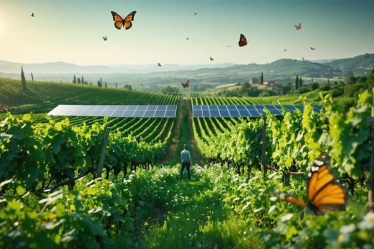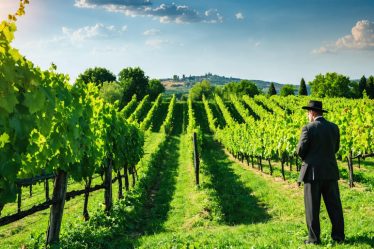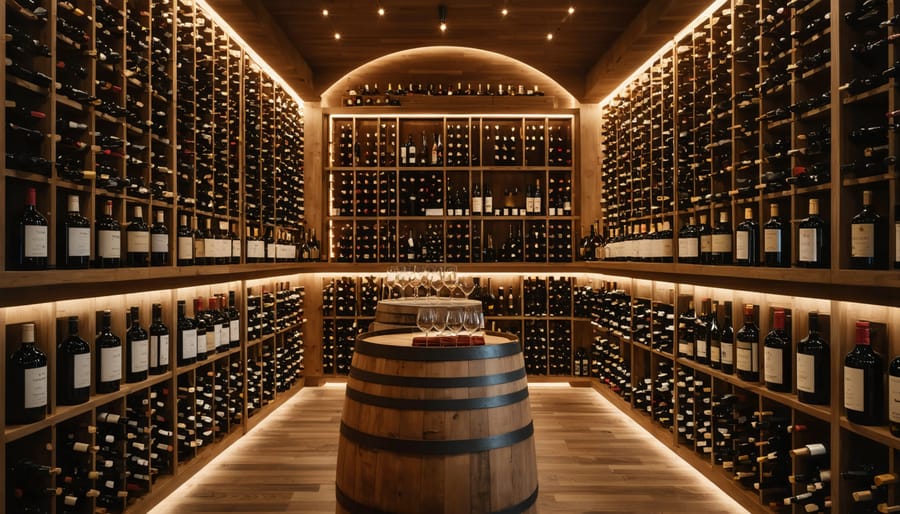
Transform your financial future by exploring strategic wine investment opportunities that combine passion with profit. Like a perfectly aged Bordeaux, successful investment strategies require careful selection, patience, and market insight. Whether you’re a seasoned investor or just beginning to explore alternative investments, wine offers a unique blend of stable returns and tangible luxury that’s increasingly attracting savvy women investors.
From collecting prestigious first-growth Bordeaux to discovering up-and-coming wine regions, your investment approach can be as diverse as your palate. The key lies in understanding market trends, storage requirements, and authentication processes while building relationships with reputable merchants and auction houses. With the fine wine market showing consistent growth over the past decade and offering portfolio diversification benefits, now is an excellent time to uncork the potential of wine investing.
Let’s explore nine proven strategies that have helped women investors build impressive wine portfolios, from focusing on blue-chip wines to leveraging emerging market opportunities. These approaches combine practical wisdom with modern investment techniques, ensuring your wine collection becomes both a source of joy and financial growth.
Building a Strong Foundation: Essential Wine Investment Strategies
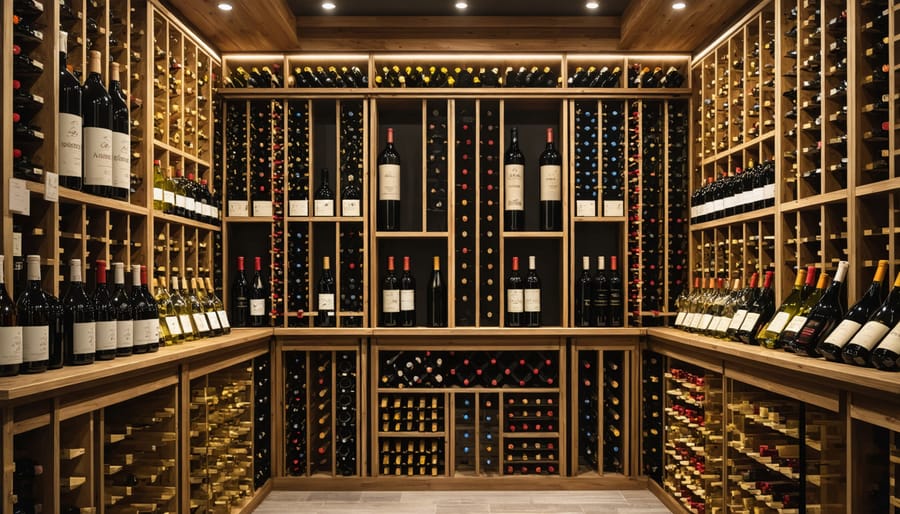
Research-Based Portfolio Building
Building a research-based wine investment portfolio starts with educating yourself through reliable wine education resources and market analysis. I’ve found that successful wine investors typically focus on three key areas: producer reputation, vintage quality, and market trends.
Start by researching prestigious wine regions and their top producers, paying special attention to those with consistent track records. I recommend creating a spreadsheet to track wine critics’ scores, particularly from respected sources like Robert Parker or Wine Spectator. Don’t forget to consider vintage conditions – exceptional years often yield better investment returns.
Follow wine auction results and market prices through platforms like Liv-ex or Wine-Searcher. These tools can help you identify emerging trends and understand price movements. I’ve learned that networking with fellow collectors and joining wine communities can provide valuable insights and investment opportunities.
Remember to diversify your portfolio across different regions, producers, and vintages. This approach helps minimize risk while maximizing potential returns. Keep detailed records of your research findings and investment decisions to refine your strategy over time.
Diversification Across Regions
When I first started exploring wine investments, I quickly learned that spreading investments across different world’s finest wine regions isn’t just about reducing risk – it’s about capturing unique opportunities in each area. Think of it as creating a beautiful wine mosaic, with each region contributing its own special character to your portfolio.
France’s Bordeaux and Burgundy regions have long been investment staples, but today’s savvy investors are also looking to emerging regions like California’s Napa Valley, Italy’s Tuscany, and Australia’s Barossa Valley. Each region experiences different climate conditions, follows unique production methods, and caters to varying market demands.
I’ve found that regional diversification helps protect against localized challenges like poor harvests or changing local regulations. Plus, different regions peak in value at different times, creating multiple opportunities for returns. Consider starting with two or three regions you’re familiar with, then gradually expanding your geographical reach as you become more comfortable with the market dynamics of each area.
Remember, regional diversity isn’t just about spreading risk – it’s about embracing the rich tapestry of global wine culture and its investment potential.
Nine Strategic Approaches to Wine Investment
En Primeur Investment
Ever heard of buying wine before it’s even bottled? That’s exactly what En Primeur investment is, and it’s like getting a sneak peek at tomorrow’s treasures! Think of it as reserving your favorite designer bag before it hits the stores, but with fine wines.
Here’s the exciting part: when you invest in En Primeur, you’re purchasing wine while it’s still aging gracefully in barrels, usually at a more attractive price point than the final bottled version. I remember my first En Primeur purchase – it felt like being part of an exclusive club of wine enthusiasts who could spot tomorrow’s stars today!
The magic typically happens with prestigious wines from regions like Bordeaux, where this practice has been a tradition for centuries. While it requires patience (you’ll wait about two years before receiving your bottles), it can be incredibly rewarding. Many of my wine-loving friends have turned modest En Primeur investments into impressive returns.
Just remember, like any investment, it’s essential to research thoroughly and work with reputable wine merchants who have established relationships with the châteaux.
Blue-Chip Wine Focus
Think of blue-chip wines as the Chanel bags of the wine world – they’re prestigious, reliable, and have a proven track record of maintaining their value. This strategy focuses on investing in established wines from renowned regions like Bordeaux and Burgundy, particularly from celebrated vintages and distinguished châteaux.
I remember chatting with Sarah, a fellow wine enthusiast, who started her collection with a case of Château Lafite Rothschild. “It felt like buying my first piece of fine jewelry,” she shared. “I knew I was investing in something truly special.”
While these wines typically require a higher initial investment, they often provide more stable returns and lower risk. Look for wines with strong critical ratings, consistent market performance, and established provenance. Premier Cru and Grand Cru classifications from prestigious French estates are particularly sought after, as are iconic Italian wines like Sassicaia and Ornellaia.
Remember, patience is key with blue-chip wines – they’re meant to be held for the long term, typically 10-15 years or more.
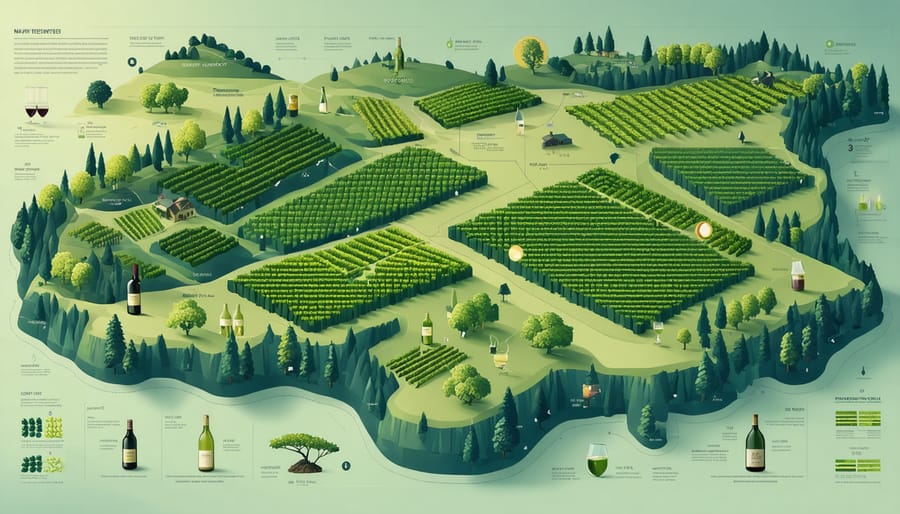
Emerging Market Opportunities
Have you ever dreamed of discovering the next Napa Valley before it hits the mainstream? One of the most exciting wine investment strategies involves exploring emerging wine regions and identifying promising producers before they become household names. I recently spoke with a friend who tripled her investment by focusing on up-and-coming wineries in New Zealand’s Central Otago region!
Look for areas experiencing climate improvements, increased international investment, or gaining recognition in wine competitions. Countries like England, with its growing sparkling wine scene, and Uruguay’s boutique producers offer fascinating opportunities. Keep an eye on smaller producers who are experimenting with innovative techniques or reviving traditional methods.
The key is to build relationships with local wine merchants and follow respected critics who spot rising stars. Consider joining wine clubs focusing on lesser-known regions – they often provide early access to limited releases that could become tomorrow’s sought-after bottles.
Vintage-Based Strategy
Just like finding the perfect vintage handbag, investing in exceptional wine vintages requires a keen eye and impeccable timing. Think of vintage-based strategy as shopping for those rare, standout years when Mother Nature blessed wine regions with perfect growing conditions. I remember when a friend shared her success story of investing in 2010 Bordeaux wines – she practically doubled her investment in just five years!
The key is to research and identify those golden years when weather conditions aligned perfectly for specific wine regions. For example, 2015 and 2016 were spectacular years for Bordeaux, while 2016 was exceptional for Tuscany. Once you identify these stellar vintages, focus your investments on wines from top producers during these years.
This strategy works particularly well because exceptional vintages tend to appreciate more consistently over time. Think of it as collecting limited-edition pieces – their rarity and quality make them increasingly valuable. Start by following wine critics’ vintage reports and ratings, and consider joining wine communities where experienced collectors share their insights about promising vintages.
Remember to diversify across different exceptional vintages rather than putting all your eggs in one basket. This approach helps balance your portfolio while maintaining focus on quality years.
Wine Investment Funds
Ever wondered about combining your love for fine wines with investment potential? Wine investment funds offer an exciting way to diversify your portfolio while indulging in the fascinating world of premium wines. Think of it as having expert sommeliers manage your wine investments, similar to how financial advisors handle traditional investment portfolios.
These professionally managed funds pool money from multiple investors to purchase and store high-quality, investment-grade wines. I recently spoke with Sarah, a friend who joined a wine fund last year, and she loves how it removes the complexity of selecting, storing, and tracking individual bottles. The fund managers handle everything from authentication to optimal storage conditions, ensuring your liquid assets maintain their value.
What makes wine funds particularly appealing is their potential for steady appreciation – premium wines typically increase in value as they age and become rarer. Plus, unlike traditional investments, wine values tend to be less affected by stock market volatility. Just remember to choose established funds with proven track records and transparent fee structures. Many funds also offer the delightful perk of occasional tastings, making this investment strategy both profitable and pleasurable!
Direct Producer Relationships
Building direct relationships with wineries is like having a backstage pass to the wine investment world. I’ve found that establishing connections with vineyard owners and winemakers can open doors to exclusive opportunities that aren’t available through traditional channels. Start by attending wine tastings, joining wine clubs, and participating in vineyard events to network with industry insiders.
These relationships can give you first access to limited releases, special vintages, and en primeur offerings (buying wine while it’s still in the barrel). Last year, I connected with a boutique Burgundy producer who now alerts me before their most sought-after wines hit the market. This early access isn’t just about getting the best prices – it’s about securing allocations of wines that might sell out before reaching wider distribution.
Remember to nurture these relationships authentically. Share your genuine appreciation for their craft, stay informed about their production methods, and maintain regular communication beyond just purchase opportunities.
Auction House Strategy
I’ll never forget my first wine auction – the excitement was palpable! Auction houses offer a thrilling way to build your wine investment portfolio, often presenting unique opportunities to acquire rare and sought-after vintages. The key is to research thoroughly before raising your paddle. Start by attending a few auctions as an observer to understand the flow and dynamics. Watch how experienced collectors bid and take note of which wines generate the most interest.
To make the most of auction opportunities, request condition reports for wines you’re interested in, and always factor in the buyer’s premium (usually 15-25%) when setting your maximum bid. Look for wines with perfect provenance – documented history of storage and ownership – as these typically hold better value. Consider joining forces with other collectors to pool resources for higher-value lots.
Don’t forget to leverage online wine auctions too – they’re becoming increasingly popular and often offer lower entry points for newcomers to wine investing.

Limited Production Focus
I discovered the allure of limited-production wines during a visit to a boutique Napa Valley winery, and it opened my eyes to an exciting investment opportunity. These rare wines, often produced in quantities of just a few hundred cases, can significantly appreciate in value over time. Think of iconic labels like Screaming Eagle or Domaine de la Romanée-Conti, where scarcity drives both demand and price.
To get started, focus on small-production wines from renowned regions and critically acclaimed vintages. Build relationships with reputable wine merchants who can alert you to limited releases, and consider joining exclusive wine clubs that offer first access to rare bottles. Remember to research proper storage conditions, as maintaining the wine’s quality is crucial for investment success.
Pro tip: Keep detailed records of purchase prices, storage conditions, and market values. This strategy requires patience and research, but the potential returns can be truly remarkable.
Long-Term Storage Strategy
Like a fine wine itself, successful wine investment requires patience and proper care. The key to maximizing returns lies in understanding proper wine storage techniques and having a dedicated space for aging your collection. I’ve learned that investing in a temperature-controlled wine cellar or professional storage facility is essential for maintaining wine quality over time.
Think of your wine collection as a carefully curated wardrobe – each bottle needs the right conditions to maintain its value. Ideal storage conditions include consistent temperatures between 55-59°F (13-15°C), humidity levels around 70%, and protection from direct sunlight and vibrations. These conditions allow wines to age gracefully, potentially increasing their value.
Remember, some wines can take 10-20 years to reach their peak drinking window, which is often when they command the highest prices. This strategy requires significant upfront investment in both the wines and storage infrastructure, but the potential returns can make it worthwhile.
Risk Management and Storage Considerations
Let’s talk about protecting your wine investments – because just like that precious vintage handbag, your wine collection needs proper care and attention! I learned this lesson the hard way when I discovered one of my first investment bottles had been stored near a radiator (definitely not ideal!).
First and foremost, temperature control is absolutely crucial. Your wine should be kept between 55-59°F (13-15°C) consistently. Think of it as giving your wines their own personal spa treatment – they need that perfect environment to maintain their quality and value. Fluctuations in temperature can be particularly damaging, so investing in a quality wine refrigerator or professional storage facility is worth every penny.
Humidity is another key factor, ideally maintained around 70%. Too dry, and those precious corks might shrink, leading to oxidation. Too humid, and you risk damaging the labels, which can significantly impact resale value. Remember, pristine labels are like a wine’s passport – they help verify authenticity and origin.
Insurance is something many collectors overlook, but it’s essential. Consider getting specialized wine insurance that covers not just theft but also damage from environmental factors. I always recommend taking detailed photographs and keeping meticulous records of your collection, including purchase dates, prices, and provenance documentation.
For larger collections, professional storage facilities offer peace of mind with perfect conditions, security, and sometimes even handling services. They might seem expensive at first, but think of it as an investment in protecting your investment – definitely worth it for those special bottles you’re planning to hold onto for the long term.
Finally, regular monitoring of your collection helps you spot any issues early on. Set calendar reminders to check your storage conditions monthly, and always keep an eye on those humidity and temperature gauges.
Now that you’re equipped with these nine diverse investment strategies, you’re ready to take your first steps into the exciting world of investing. Remember, there’s no one-size-fits-all approach – the key is finding what aligns with your personal goals, risk tolerance, and lifestyle. Whether you’re drawn to the steady approach of dollar-cost averaging or excited by the potential of growth investing, start small and gradually build your confidence.
Consider beginning with one or two strategies that resonate most with you, and don’t hesitate to adjust your approach as you learn and grow. Keep educating yourself through reliable resources, connect with like-minded investors in your community, and perhaps even find a mentor who can guide you along your journey.
The most important thing is to start. Even if you begin with small investments, you’re already ahead of those who haven’t taken that first step. Remember to regularly review and rebalance your portfolio, stay informed about market trends, and remain patient with your investment journey. Your future self will thank you for the financial wisdom you’re cultivating today.

